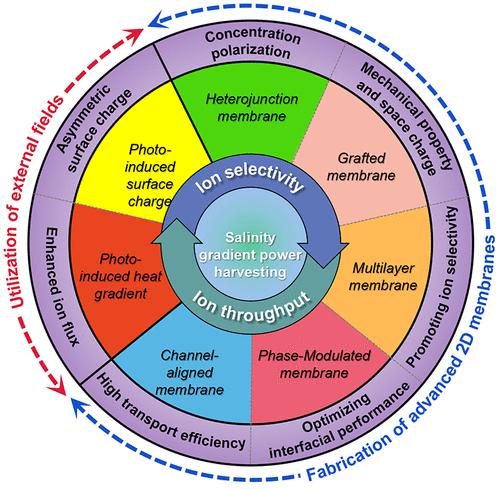当前位置:
X-MOL 学术
›
Acc. Chem. Res.
›
论文详情
Our official English website, www.x-mol.net, welcomes your
feedback! (Note: you will need to create a separate account there.)
Two-Dimensional Nanofluidic Membranes toward Harvesting Salinity Gradient Power
Accounts of Chemical Research ( IF 16.4 ) Pub Date : 2021-10-31 , DOI: 10.1021/acs.accounts.1c00431 Weiwen Xin 1, 2 , Lei Jiang 1, 2 , Liping Wen 1, 2
Accounts of Chemical Research ( IF 16.4 ) Pub Date : 2021-10-31 , DOI: 10.1021/acs.accounts.1c00431 Weiwen Xin 1, 2 , Lei Jiang 1, 2 , Liping Wen 1, 2
Affiliation

|
The salinity gradient between seawater and river water has been identified as a promising, clean, renewable, and sustainable energy source that can be converted into electricity using ion-selective membranes in a reverse electrodialysis (RED) configuration. However, the major hindrance to current salinity gradient power (SGP) conversion is its poor energy efficiency due to the use of low-performance membrane processes, which affords power for neither miniaturized devices nor industrial-level applications. Nanofluidics, which combines strong confinement and surface charge effects at the nanoscale, contributes to novel transport properties, including excellent ion selectivity and high ion throughput; thus, nanofluidics may lead to technological breakthroughs and act as an emerging platform for harnessing SGP. Recently, two-dimensional (2D) materials have provided impressive energy extraction performance and further insight into fundamental transport mechanisms and theoretical feasibility. To reach the commercialization benchmark and real-world applications, an array of nanopores and channels that can be scaled up to industrial sizes is in high demand; additionally, it remains challenging to develop macroscale nanofluidic membranes that meet the “selectivity versus throughput” dual requirement. In the first section, we start with our understanding of the underlying mechanism of ion–channel interactions and transport characteristics in nanofluidic channel systems from the microscale to the macroscale. We review our recent efforts in this field by constructing a heterojunction with asymmetric ion transport behavior that generates rectification of the ion flux and creates an osmotic diode, which is composed of two nanofluidic layers with opposite polar charges and different chemical compositions. Another efficient way to improve the performance of the system is introducing charged functional materials intercalated into laminar 2D nanosheets. The intercalated nanofluidic material can be explained by two classical models to account for the synergistic effects that (i) improve the stability and mechanical properties of 2D materials with a fixed interlayer spacing and (ii) provide space charge for modulating ion diffusion; both of these effects contribute to its considerable energy conversion performance. Further, layer-by-layer membranes are superior to traditional membranes consisting of a simple stack because they retain their repulsion effect toward co-ions, largely strengthening the efficiency of ion separation and conversion. In particular, we highlight our views on the role of the 2D phase structure (e.g., semiconductor 2H phase and metallic 1T phase) in which the two phases differ from each other in physical and chemical properties, including ionic conductance, surface charge, and wetting, thereby presenting a state-of-the-art avenue for controlling ion transport. In view of the nature of 2D materials, we also report improved osmotic energy harvesting by exploiting the photoinduced heat gradient and electrons that increase ion mobility and surface charge, respectively. Finally, we point out specific research topics in which a combined project can certainly come into the limelight. For example, we discuss the combination of SGP with desalination systems and water splitting. We expect that this Account will stimulate further efforts toward functionalized 2D nanoporous materials and facilitate interdisciplinary efforts in chemistry, material engineering, environmental science, and nanotechnology.
中文翻译:

用于获取盐度梯度功率的二维纳米流体膜
海水和河水之间的盐度梯度已被确定为一种有前途的、清洁的、可再生的和可持续的能源,可以在反向电渗析 (RED) 配置中使用离子选择性膜将其转化为电能。然而,当前盐度梯度功率 (SGP) 转换的主要障碍是由于使用了低性能膜工艺,其能源效率低下,既不能为小型化设备也不能为工业级应用提供动力。纳米流体在纳米尺度上结合了强约束和表面电荷效应,有助于实现新的传输特性,包括出色的离子选择性和高离子通量;因此,纳米流体可能会带来技术突破,并成为利用 SGP 的新兴平台。最近,二维 (2D) 材料提供了令人印象深刻的能量提取性能,并进一步深入了解了基本的传输机制和理论可行性。为了达到商业化基准和实际应用,需要大量可扩展到工业尺寸的纳米孔和通道;此外,开发满足“选择性与通量”双重要求的宏观纳米流体膜仍然具有挑战性。在第一部分中,我们首先了解纳米流体通道系统中从微观尺度到宏观尺度的离子通道相互作用和传输特性的潜在机制。我们通过构建具有不对称离子传输行为的异质结来回顾我们最近在该领域的努力,该异质结会产生离子通量的整流并创建渗透二极管,该二极管由两个具有相反极性电荷和不同化学成分的纳米流体层组成。提高系统性能的另一种有效方法是将带电功能材料插入到层状二维纳米片中。嵌入的纳米流体材料可以用两个经典模型来解释,以解释以下协同效应:(i)提高具有固定层间距的二维材料的稳定性和机械性能,以及(ii)为调节离子扩散提供空间电荷;这两种效应都有助于其可观的能量转换性能。更远,逐层膜优于传统的由简单堆叠组成的膜,因为它们保留了对共离子的排斥作用,大大增强了离子分离和转化的效率。特别是,我们强调了我们对二维相结构(例如,半导体 2H 相和金属 1T 相)的作用的看法,其中两相在物理和化学性质上彼此不同,包括离子电导、表面电荷和润湿,从而为控制离子传输提供了最先进的途径。鉴于二维材料的性质,我们还报告了通过利用分别增加离子迁移率和表面电荷的光致热梯度和电子来改进渗透能收集。最后,我们指出了特定的研究课题,在这些课题中,联合项目肯定会成为众人瞩目的焦点。例如,我们讨论了 SGP 与海水淡化系统和水分解的组合。我们预计该帐户将刺激功能化二维纳米多孔材料的进一步努力,并促进化学、材料工程、环境科学和纳米技术方面的跨学科努力。
更新日期:2021-11-16
中文翻译:

用于获取盐度梯度功率的二维纳米流体膜
海水和河水之间的盐度梯度已被确定为一种有前途的、清洁的、可再生的和可持续的能源,可以在反向电渗析 (RED) 配置中使用离子选择性膜将其转化为电能。然而,当前盐度梯度功率 (SGP) 转换的主要障碍是由于使用了低性能膜工艺,其能源效率低下,既不能为小型化设备也不能为工业级应用提供动力。纳米流体在纳米尺度上结合了强约束和表面电荷效应,有助于实现新的传输特性,包括出色的离子选择性和高离子通量;因此,纳米流体可能会带来技术突破,并成为利用 SGP 的新兴平台。最近,二维 (2D) 材料提供了令人印象深刻的能量提取性能,并进一步深入了解了基本的传输机制和理论可行性。为了达到商业化基准和实际应用,需要大量可扩展到工业尺寸的纳米孔和通道;此外,开发满足“选择性与通量”双重要求的宏观纳米流体膜仍然具有挑战性。在第一部分中,我们首先了解纳米流体通道系统中从微观尺度到宏观尺度的离子通道相互作用和传输特性的潜在机制。我们通过构建具有不对称离子传输行为的异质结来回顾我们最近在该领域的努力,该异质结会产生离子通量的整流并创建渗透二极管,该二极管由两个具有相反极性电荷和不同化学成分的纳米流体层组成。提高系统性能的另一种有效方法是将带电功能材料插入到层状二维纳米片中。嵌入的纳米流体材料可以用两个经典模型来解释,以解释以下协同效应:(i)提高具有固定层间距的二维材料的稳定性和机械性能,以及(ii)为调节离子扩散提供空间电荷;这两种效应都有助于其可观的能量转换性能。更远,逐层膜优于传统的由简单堆叠组成的膜,因为它们保留了对共离子的排斥作用,大大增强了离子分离和转化的效率。特别是,我们强调了我们对二维相结构(例如,半导体 2H 相和金属 1T 相)的作用的看法,其中两相在物理和化学性质上彼此不同,包括离子电导、表面电荷和润湿,从而为控制离子传输提供了最先进的途径。鉴于二维材料的性质,我们还报告了通过利用分别增加离子迁移率和表面电荷的光致热梯度和电子来改进渗透能收集。最后,我们指出了特定的研究课题,在这些课题中,联合项目肯定会成为众人瞩目的焦点。例如,我们讨论了 SGP 与海水淡化系统和水分解的组合。我们预计该帐户将刺激功能化二维纳米多孔材料的进一步努力,并促进化学、材料工程、环境科学和纳米技术方面的跨学科努力。











































 京公网安备 11010802027423号
京公网安备 11010802027423号